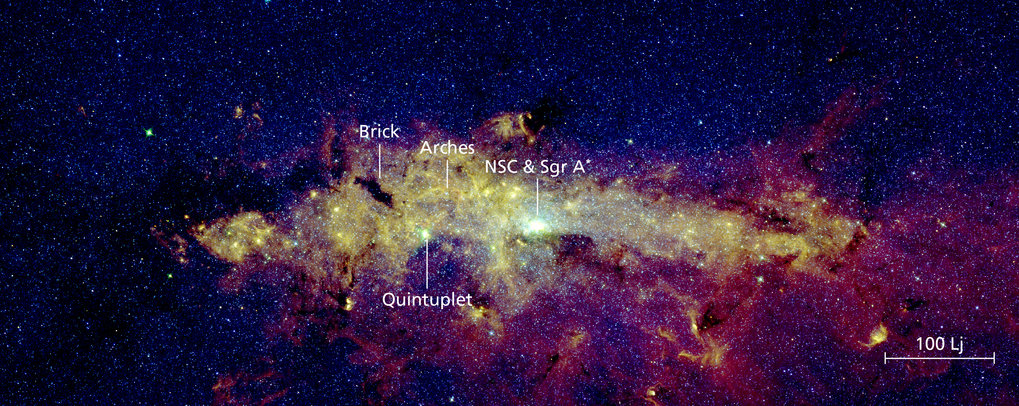Mysterious cloud near galactic center may be richer in young stars than previously thought
A research group led by the Max Planck Institute for Astronomy has found evidence of a young star cluster in a cloud known as the Brick. This cloud near the galactic center has so far seemed unusually quiet in terms of star formation. The new discovery results from an arched partial structure, the characteristics of which correspond to an expanding structure. The authors relate it to a bubble of hot gas created by the winds of a young, massive star. Since massive stars rarely form in isolation, the bubble may indicate the presence of a young star cluster spanning several hundred solar masses.
The image is a three-color composite of CMZ that highlights some of its most distinctive features. Interpretations explain the location of some of the Milky Way’s most massive star clusters, such as the Nuclear Star Cluster (NSC), Arcs, and the Pentagram. The “brick” is a clear dark cloud that absorbs light and appears as a silhouette against a light background.
© Henshaw / MPIA
Stars form within dense regions in clouds of gas and dust. In general, if the cloud is dense enough, at some point stars will appear. However, this general rule does not seem to apply entirely to the area around the center of the Milky Way. Central Molecular Zone (CMZ, English for central molecular region), a gas complex 1,000 to 2,000 light-years in diameter around the galactic center, containing some of the densest and largest known gas clouds in the Milky Way. Aside from a few exceptionally massive star clusters, many of these clouds show surprisingly little evidence of widespread star-forming activity.
To investigate this apparent discrepancy, a team led by Jonathan Henshaw of the Max Planck Institute for Astronomy (MPIA) in Heidelberg examined one of the CMZ’s most mysterious clouds – the so-called “brick”. It is famous for its high density and mass equivalent to about 100,000 suns. However, it appears to produce relatively few stars.
“When examining the gas movement in the bricks, one component in particular stands out,” Henshaw says. He is the lead author of the main article, which appears in Monthly Notices of the Royal Astronomical Society has been published. “This infrastructure, which is limited to a narrow velocity range, is like a crescent-shaped arc,” adds the researcher.

The arc (dark black line) is a partial crescent-shaped structure of a “brick”, which is a dense and massive cloud of gas and dust within the central molecular region. The possible origin of the arc is an envelope stretching around a bubble of hot gas. The supposedly massive star’s winds are driving the expansion of this bubble.
© Photo: Henshaw / MPIA
Such arcs have been discovered in regions of massive star formation and may represent material being carried away by the expanding gas envelope. Massive stars give energy and momentum to their surroundings, which acts as a driving force for expansion. Based on this assumption, the research group determined the diameter of the envelope is 8.5 light-years and an expansion speed of about five kilometers per second. By tracing this movement to its origin, astronomers have dated the beginning of the expansion to a few hundred thousand years ago. Given the typical time scales of cosmic phenomena, this is only the blink of an eye.
Interestingly, Jonathan Henshaw and colleagues also found ionized gas emissions to coincide with the cavity within the arc. This gas, which was detected by radio emissions, has a velocity that matches the motion of the arc – indicating a direct relationship between hot ionized and cold molecular gases.
“We examined several potential scenarios for the expansion of the envelope that forms the arc,” Henshaw continues, “when we compared the theoretical predictions with our observations, we found that winds coming from a star equal to about 20 times the mass of the Sun are likely to be the dominant mechanism.”
In general, the most likely explanation so far for the origin of the arc is the idea of an expanding bubble of hot gas pushed by the winds from a massive star that formed inside the bricks. This result puts seemingly inert bricks in a whole new light. Massive stars rarely arise in isolation. Usually it is a sign of a whole group of young stars of different masses. If this is the case with the build module, you may be more active than previously assumed.
To estimate the mass of the suspected group of stars, astronomers simulated 10,000 star clusters. Statistical analysis of those clusters in which the largest stars have a mass of 16 to 20 times the mass of the Sun indicates a range of masses of between 400 and 700 solar masses. The authors of the core research article also showed that with the tools currently available, such clusters could be easily hidden in the mixture of many stars observed toward the galactic center, and by gas and dust interfering on these stars.
In order to better get to know the stars inside the bricks, astronomers hope to acquire the James Webb Space Telescope, which is scheduled to be launched into space in 2021. Its results will help you identify the clusters of stars in the bricks and possibly find the reason for the formation of the arc.
Basic information
The team consists of JD Henshaw (Max Planck Institute for Astronomy, Heidelberg, Germany [MPIA]), M.R. Krumholz (MPIA; Australian National University, Canberra, Australia; ARC Center of Excellence for Astronomy in Three Dimensions, Canberra, Australia; ZAH, University of Heidelberg, Deutschland), NU Butterfield (Villanova University, USA), c. Dublin Institute for Advanced Study, Ireland), Prof. Ginsburg (University of Florida, Gainesville, USA [UFL]), TJ Haworth (Queen Mary University of London, UK), F. Nogueras-Lara (MPIA), AT Barnes (Universität Bonn, Deutschland), SN Longmore (University of Liverpool John Moores, UK), J. Bally (University of Colorado, USA), JMD Kruijssen (ARI, Universität Heidelberg, Deutschland), EAC Mills (University of Kansas, Lawrence, USA), H. Beuther (MPIA), DL Walker (University of Connecticut, Storrs, USA) [UCONN]), C. Battersby (UCONN), A. Bulatek (UFL), T. Henning (MPIA), and J. Ott (National Observatory for Radio Astronomy, Socorro, USA; New Mexico Institute of Mining and Technology, Socorro, USA ) and J.D. Soler (MPIA; Institute of Astrophysics and Planetary Science, National Institute of Astrophysics, Rome, Italy).
MN

Communicator. Reader. Hipster-friendly introvert. General zombie specialist. Tv trailblazer

